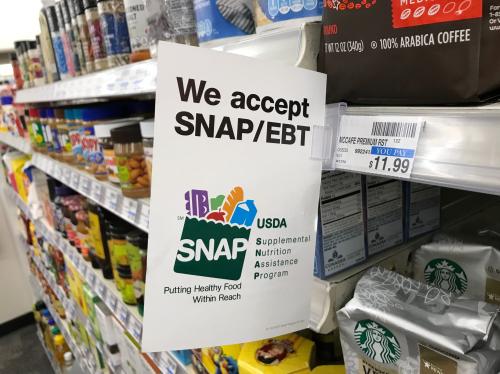On August 16, the U.S. Department of Agriculture (USDA) announced changes to the Thrifty Food Plan which will result in increases in Supplemental Nutritional Assistance Program (SNAP; formerly the Food Stamp Program) benefits of about 20-25 percent from pre-pandemic levels. The reevaluation of the Thrifty Food Plan was directed by Congress in the 2018 Farm Bill. It is overdue for an update.
“What,” you might be asking yourself, “is the ‘Thrifty Food Plan’? Is it perhaps a new entry into the endless parade of meal kits advertised on my social media stream promising to deliver healthful deliciousness in a creative, time-saving, affordable, and recyclable package?” No, it is not. The Thrifty Food Plan (“The Thrifty”) is the model family food plan that sets the benefit amounts for families who receive SNAP.
More than 50 years ago, the USDA designed a meal plan that would theoretically deliver adequate nutrition to a family, figured out how much that would cost, and based food stamp benefit levels on that plan. Aside from annual adjustments for inflation, the value of the maximum SNAP benefit has been held constant to how much it cost when the measure was first calculated in the 1960s. But food costs do not move in lockstep with overall inflation. As a result, the purchasing power of SNAP benefits, pinned to this decades-old level, is starkly lower than when the original Thrifty was designed.
Because it can be extremely tricky to feed a family on the budget suggested by the Thrifty, the USDA occasionally puts out meal plans and recipes that demonstrate how one could make it all work. The food writer Jeffrey Steingarten famously tried to stick to the Thrifty menu for a week (he “resigned” on day five, reasoning “four days is almost a week,”) and recounted his experience in his 1993 essay “Staying Alive,” (included in his memoir The Man Who Ate Everything). While he took little delight in the recipes (saying only of the Stove-Top Beans: “I would make these again.”) he did note the ingenuity of the design: “But the planning was clever: buying and cooking in large amounts, using leftovers in other dishes, and eliminating all precooked and convenience foods. If you are poor enough for food stamps, it is assumed you will have all the time in the world to cook everything from scratch.”
And therein lies the problem that the new Thrifty Food Plan is meant to help. Think about the changes in family life in the last 50 years: in the 1970s, fewer than half of married women with children under 18 worked. By 2015, nearly 70 percent of married women with minor children did so. The percentages are even higher for never-married or divorced women with children. The resulting time crunch has changed how we all cook and eat—and boosted a range of time-saving cooking techniques including the Instapot, a range of recipes touting that they’re “30 minute meals,” and new time-saving foods like bagged salads, all meant to help time-strapped families get dinner on the table.
For too long SNAP has been shackled to an outdated model of how families live and eat.
Under the current Thrifty (in effect from 2006), few of these time saving foods were in the budget for SNAP families. Research shows that the menu implied by the current Thrifty would require about two hours per day for cooking, shopping, and cleaning up. But, just like the rest of American parents, parents on SNAP are increasingly employed as well: 87% of SNAP receiving households with kids report working in the last year, and research I’ve done shows that the types of jobs SNAP recipients have are low-paying, time-consuming, and volatile. (And it’s worth nothing that in the COVID-19 era, many of these jobs were deemed “essential”). The 2021 revised Thrifty uses the latest data to measure the costs of food, allows for more time-savers like canned beans instead of dried, models the diet on what healthy Americans actually eat, and, importantly, it doesn’t adhere to that more than 50-year-old cost constraint.
What does the research show to be the benefits of providing nutritional supports for low-income families? In the short term, we’ll see fewer children and families experience hunger. For example, enhanced SNAP benefits that were implemented in response to the COVID-19 crisis— “pandemic EBT”—lifted 3-4 million children out of hunger. In the longer term, there is evidence that children on SNAP grow up to be healthier, live longer, are more likely to complete high school, have better economic outcomes, and are less likely to be incarcerated compared to similar people not covered by these benefits. Indeed, part of this increased spending on SNAP should be thought of as a long-term investment in children.
We face ongoing issues with diet-related health conditions, including among children, which the COVID-19 pandemic has likely exacerbated. Research that I’ve done indicates that higher SNAP benefits are associated with better diet quality. And I suspect that most people who are their household’s primary shopper and meal-preparer can lean into their intuition here that a healthy diet with plenty of fresh fruits and vegetables is not a cheap one—especially if you are short on time.
For too long SNAP has been shackled to an outdated model of how families live and eat. To be sure, since monthly benefit levels will only increase by about $36 per person, the meal plan is still going to be plenty “thrifty.” But it will at least recognize that low-income families might need to use a bag of pre-washed lettuce and some baby carrots to get a healthy dinner on the table.
The Brookings Institution is financed through the support of a diverse array of foundations, corporations, governments, individuals, as well as an endowment. A list of donors can be found in our annual reports published online here. The findings, interpretations, and conclusions in this report are solely those of its author(s) and are not influenced by any donation.
-
Acknowledgements and disclosures
The author thanks Stephanie Aarsonson, Lauren Bauer, Ariel Gelrud Shiro, Brynne Keith-Jennings, Joseph Llobrera, Christopher Pulliam, Richard Reeves, and Diane Schanzenbach for comments.
The Brookings Institution is committed to quality, independence, and impact.
We are supported by a diverse array of funders. In line with our values and policies, each Brookings publication represents the sole views of its author(s).






Commentary
Op-edThe new Thrifty Food Plan re-evaluates a 50-plus-year-old design and low-income kids will benefit
September 1, 2021